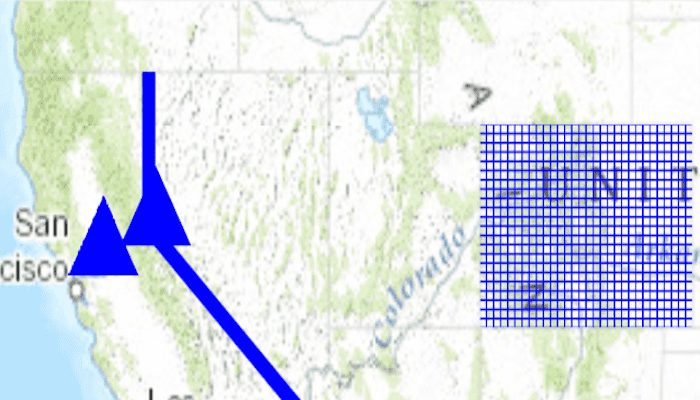Create simple geometry types.

Use case
Geometries are used to represent real world features as vector GIS data. Points are used to mark specific XY locations, such as landmarks and other points of interest. Polylines are made up of 2 or more XY vertices and can be used to mark roads, flight paths, or boundaries. Polygons are made up of 3 or more XY vertices and can be used to represent a lake, country, or a park. Geometries can be stored as features in a database, displayed as Graphics in a map, or used for performing spatial analysis with GeometryEngine or a GeoprocessingTask.
How to use the sample
Pan and zoom freely to see the different types of geometries placed onto the map.
How it works
- Use the constructors for the various simple
Geometrytypes includingPoint,Polyline,Multipoint,Polygon, andEnvelope. - To display the geometry, create a
Graphicpassing in the geometry, and aSymbolappropriate for the geometry type. - Add the graphic to a graphics overlay and add the overlay to a map view.
Relevant API
- Envelope
- Multipoint
- Point
- PointCollection
- Polygon
- Polyline
Additional information
A geometry made of multiple points usually takes a PointCollection as an argument or is created through a builder.
Tags
area, boundary, line, marker, path, shape
Sample Code
/* Copyright 2016 Esri
*
* Licensed under the Apache License, Version 2.0 (the "License");
* you may not use this file except in compliance with the License.
* You may obtain a copy of the License at
*
* http://www.apache.org/licenses/LICENSE-2.0
*
* Unless required by applicable law or agreed to in writing, software
* distributed under the License is distributed on an "AS IS" BASIS,
* WITHOUT WARRANTIES OR CONDITIONS OF ANY KIND, either express or implied.
* See the License for the specific language governing permissions and
* limitations under the License.
*
*/
package com.esri.arcgisruntime.sample.creategeometries;
import android.graphics.Color;
import android.os.Bundle;
import androidx.appcompat.app.AppCompatActivity;
import com.esri.arcgisruntime.ArcGISRuntimeEnvironment;
import com.esri.arcgisruntime.geometry.Envelope;
import com.esri.arcgisruntime.geometry.Multipoint;
import com.esri.arcgisruntime.geometry.Point;
import com.esri.arcgisruntime.geometry.PointCollection;
import com.esri.arcgisruntime.geometry.Polygon;
import com.esri.arcgisruntime.geometry.Polyline;
import com.esri.arcgisruntime.geometry.SpatialReferences;
import com.esri.arcgisruntime.mapping.ArcGISMap;
import com.esri.arcgisruntime.mapping.BasemapStyle;
import com.esri.arcgisruntime.mapping.view.Graphic;
import com.esri.arcgisruntime.mapping.view.GraphicsOverlay;
import com.esri.arcgisruntime.mapping.view.MapView;
import com.esri.arcgisruntime.symbology.SimpleFillSymbol;
import com.esri.arcgisruntime.symbology.SimpleLineSymbol;
import com.esri.arcgisruntime.symbology.SimpleMarkerSymbol;
/**
* Shows straightforward ways to create Point, Envelope, Multipoint, Polyline, and Polygon geometries. Shows a MapView
* with a GraphicsOverlay containing Graphics created from the Point, Multipoint, Polyline, and Polygon geometries, and
* sets the Viewpoint of the Map from the Envelope geometry.
*/
public class MainActivity extends AppCompatActivity {
private MapView mMapView;
private Envelope createEnvelope() {
//[DocRef: Name=Create Envelope, Category=Fundamentals, Topic=Geometries]
// create an Envelope using minimum and maximum x,y coordinates and a SpatialReference
Envelope envelope = new Envelope(-123.0, 33.5, -101.0, 48.0, SpatialReferences.getWgs84());
//[DocRef: END]
return envelope;
}
private Point createPoint() {
//[DocRef: Name=Create Point, Category=Fundamentals, Topic=Geometries]
// create a Point using x,y coordinates and a SpatialReference
Point pt = new Point(34.056295, -117.195800, SpatialReferences.getWgs84());
//[DocRef: END]
return pt;
}
private Multipoint createMultipoint() {
//[DocRef: Name=Create Multipoint, Category=Fundamentals, Topic=Geometries]
// create a Multipoint from a PointCollection
PointCollection stateCapitalsPST = new PointCollection(SpatialReferences.getWgs84());
stateCapitalsPST.add(-121.491014, 38.579065); // Sacramento, CA
stateCapitalsPST.add(-122.891366, 47.039231); // Olympia, WA
stateCapitalsPST.add(-123.043814, 44.93326); // Salem, OR
stateCapitalsPST.add(-119.766999, 39.164885); // Carson City, NV
Multipoint multipoint = new Multipoint(stateCapitalsPST);
//[DocRef: END]
return multipoint;
}
private Polyline createPolyline() {
//[DocRef: Name=Create Polyline, Category=Fundamentals, Topic=Geometries]
// create a Polyline from a PointCollection
PointCollection borderCAtoNV = new PointCollection(SpatialReferences.getWgs84());
borderCAtoNV.add(-119.992, 41.989);
borderCAtoNV.add(-119.994, 38.994);
borderCAtoNV.add(-114.620, 35.0);
Polyline polyline = new Polyline(borderCAtoNV);
//[DocRef: END]
return polyline;
}
private Polygon createPolygon() {
//[DocRef: Name=Create Polygon, Category=Fundamentals, Topic=Geometries]
// create a Polygon from a PointCollection
PointCollection coloradoCorners = new PointCollection(SpatialReferences.getWgs84());
coloradoCorners.add(-109.048, 40.998);
coloradoCorners.add(-102.047, 40.998);
coloradoCorners.add(-102.037, 36.989);
coloradoCorners.add(-109.048, 36.998);
Polygon polygon = new Polygon(coloradoCorners);
//[DocRef: END]
return polygon;
}
@Override
protected void onCreate(Bundle savedInstanceState) {
super.onCreate(savedInstanceState);
setContentView(R.layout.activity_main);
// authentication with an API key or named user is required to access basemaps and other
// location services
ArcGISRuntimeEnvironment.setApiKey(BuildConfig.API_KEY);
// get MapView from layout
mMapView = findViewById(R.id.mapView);
// create a map with the Basemap Style topographic
final ArcGISMap mMap = new ArcGISMap(BasemapStyle.ARCGIS_TOPOGRAPHIC);
// set the map to be displayed in this view
mMapView.setMap(mMap);
// create color and symbols for drawing graphics
SimpleMarkerSymbol markerSymbol = new SimpleMarkerSymbol(SimpleMarkerSymbol.Style.TRIANGLE, Color.BLUE, 14);
SimpleFillSymbol fillSymbol = new SimpleFillSymbol(SimpleFillSymbol.Style.CROSS, Color.BLUE, null);
SimpleLineSymbol lineSymbol = new SimpleLineSymbol(SimpleLineSymbol.Style.SOLID, Color.BLUE, 3);
// add a graphic of point, multipoint, polyline and polygon.
GraphicsOverlay overlay = new GraphicsOverlay();
mMapView.getGraphicsOverlays().add(overlay);
overlay.getGraphics().add(new Graphic(createPolygon(), fillSymbol));
overlay.getGraphics().add(new Graphic(createPolyline(), lineSymbol));
overlay.getGraphics().add(new Graphic(createMultipoint(), markerSymbol));
overlay.getGraphics().add(new Graphic(createPoint(), markerSymbol));
// use the envelope to set the map viewpoint
mMapView.setViewpointGeometryAsync(createEnvelope(), getResources().getDimension(R.dimen.viewpoint_padding));
}
@Override
protected void onPause() {
super.onPause();
mMapView.pause();
}
@Override
protected void onResume() {
super.onResume();
mMapView.resume();
}
@Override
protected void onDestroy() {
super.onDestroy();
mMapView.dispose();
}
}